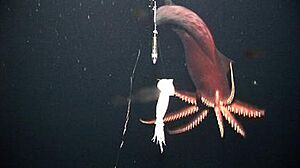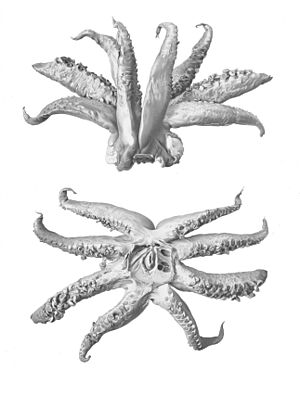Dana octopus squid facts for kids
Quick facts for kids Dana octopus squid |
|
|---|---|
 |
|
| Conservation status | |
| Scientific classification | |
| Synonyms | |
|
The Dana octopus squid (Taningia danae) is a very large type of squid. It belongs to the family Octopoteuthidae. This amazing creature is one of the biggest known squid species.
It can grow quite long. Its main body, called the mantle, can reach about 1.7 m (5.6 ft). Its total length, including its arms, can be up to 2.3 m (7.5 ft). The heaviest Dana octopus squid ever found was a female. She weighed about 161.4 kg (356 lb).
This squid is named after a Danish scientist. His name was Åge Vedel Tåning (1890–1958). He often traveled on a research ship called the Dana.
Contents
How Dana Octopus Squids Live
Making Their Own Light
The Dana octopus squid can make its own light. This is called bioluminescence. Other squids in its family can do this too. It has special light-making organs called photophores. These organs are very large. They can be as big as your fist or a lemon!
The squid has a black cover over these light organs. This cover works like an eyelid. It lets the squid blink its lights on and off.
Hunting with Light
In 2005, a research team from Japan filmed the Dana octopus squid. This was the first time anyone saw it in its natural home. The video was shot deep in the Pacific Ocean. It showed the squid using its bright lights. It would flash them from its arms when it attacked prey.
Scientists think these bright flashes help the squid in a few ways. They might confuse or stun other animals. This makes it easier for the squid to catch them. The flashes also light up the prey. This helps the squid see in the dark ocean. These light flashes might also be used to attract a mate. They could also be used to show other squids where its territory is.
Light as a Defense
The Dana octopus squid's light can also help it stay safe. Young squids have been seen using their lights to scare away predators. They move quickly towards a threat. This makes it look like they are attacking. This surprise move can confuse and startle the predator.
In 2012, this squid was filmed two more times. This happened during a search for the giant squid. The footage was part of a TV show called Monster Squid: The Giant Is Real.
Where They Are Found
Sometimes, parts of Dana octopus squids wash up on beaches. In 2008, a piece of its mantle was found in Bermuda. Later, parts of its tentacles were found nearby. In 2013, a 54 kg (119 lb) squid was caught by a fishing net. It was found off the coast of Galicia, Spain. This squid was given to the Spanish Institute of Oceanography to study.
Ocean Food Chain
Scientists have studied the Dana octopus squid's diet. They found that it is a top predator in its ocean home. This means it hunts and eats many other animals. But, the Dana octopus squid is also eaten by other animals. For example, sperm whales hunt and eat these large squids.
See also
- Giant squid
- Giant squid in popular culture




